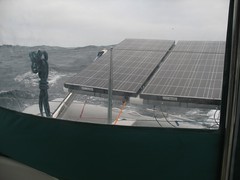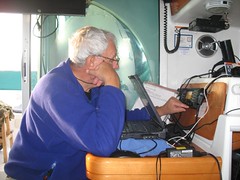One of the most draining aspects of passage making is the volume. I had not anticipated how loud it is when you go to sea. There are many sources of noise when you are in large wind and wave -- most irregular and several highly disturbing. The din takes time to adjust to as your hind brain sorts through the cacophony and starts to selectively ignore the bangs and beeps it can do nothing about. Until this process is complete, you will find it nearly impossible to concentrate or to sleep. I encourage you to feed your hind brain in advance with multivits and a couple of hours of Discovery Channel shows about our Neanderthal ancestors to remind it of its incredible adaptive abilities. Confidence in passage making is key.
Consistently, the loudest noise is the slapping of water against the hull. Even time spent cruising bays, sounds and inner passages and nights on a rocky anchor does not prepare you for the volume of wave slap in ocean swell. There are swooshy gliding sounds as the boat surfs over and through waves. There are splashy splochy sounds as waves crest nearby and drench the deck. Then there are the wappy, smacky sounds as wavelets beat themselves to death on the obdurate fiberglass of the hull.
The ones that really get you going, though, are the really loud bangs which sound exactly like a 2 x 4 wielding sea monster has reached up from the depths and rapped your boat sharply on her nose. These whacks do not in any way sound like water. You will be convinced the first two to three hundred times this happens that the boat has just run into a large tree. It is, even after the thousandth time, nearly impossible to comprehend that the sound is generated by a wave bashing its head against the beam. I challenge you to sleep through these even with the most highly evolved hind brain.
Catamarans in particular are also plagued by something known as "bridge deck boom." This is the sound generated by waves slapping against the bottom of the bridge deck between the two hulls. All catamarans boom. Or more precisely, for every catamaran there is a set of wind and wave conditions which make the boat boom. Designers around the world work to reduce the boom through baffles, angles and nacelles, height above water, and other factors. This results in models which are more "boomy" than others. However, no design escapes booming entirely.
When you get a boom condition, a large volume of water hits the underside of the salon like a toddler with a drum strick on mommy's favorite antique dresser. The shape of the boat, the air space within, create a perfect resonating chamber. The boom radiates out of the salon and down into the cabins where it works its way from your feet up to your eyebrows and fades out the top of your head.
In addition to wave noise, sound emits from your source of fuel. If you are motoring, there is the constant drone of a large diesel engine. If the wind is strong enough to enable you to sail, it is strong enough to vibrate the mast and tensioned running rigging. If the wind is really strong, the combined wind and wave outside sound like a freight train rolling over the boat.
Underlying all the big sounds are the endless number of tiny sounds which roll together into a white noise of clacks, creaks, squeaks, pops, and bangs. Plates, cups, utensils in lockers. The flashlight rolling on a counter. A soft flap of paperbacks rocking back and forth on the shelf. A strange buzz from the stove vibrating in resonance with the engines. The Coast Guard on VFH channel 16 droning on about bar reports, the sound of air flowing through the empty galley sink drain, a spare halyard knocking against the mast, your stomach growling, the kitten purring cat food breath into your ear. I can't catalog all the sources, and there is simply no way you could control them all through padding, oiling, and diligent desqueakifying.
At 0400 having been on watch for three hours, with the red lights dimly illuminating the salon, a new sound emerges. The sound is deep, low, liquid, and buzzes along the nerves with the after effects of sleep deprivation, over caffeination, and exhaustion. This is the sound of my brain melting.
Consistently, the loudest noise is the slapping of water against the hull. Even time spent cruising bays, sounds and inner passages and nights on a rocky anchor does not prepare you for the volume of wave slap in ocean swell. There are swooshy gliding sounds as the boat surfs over and through waves. There are splashy splochy sounds as waves crest nearby and drench the deck. Then there are the wappy, smacky sounds as wavelets beat themselves to death on the obdurate fiberglass of the hull.
The ones that really get you going, though, are the really loud bangs which sound exactly like a 2 x 4 wielding sea monster has reached up from the depths and rapped your boat sharply on her nose. These whacks do not in any way sound like water. You will be convinced the first two to three hundred times this happens that the boat has just run into a large tree. It is, even after the thousandth time, nearly impossible to comprehend that the sound is generated by a wave bashing its head against the beam. I challenge you to sleep through these even with the most highly evolved hind brain.
Catamarans in particular are also plagued by something known as "bridge deck boom." This is the sound generated by waves slapping against the bottom of the bridge deck between the two hulls. All catamarans boom. Or more precisely, for every catamaran there is a set of wind and wave conditions which make the boat boom. Designers around the world work to reduce the boom through baffles, angles and nacelles, height above water, and other factors. This results in models which are more "boomy" than others. However, no design escapes booming entirely.
When you get a boom condition, a large volume of water hits the underside of the salon like a toddler with a drum strick on mommy's favorite antique dresser. The shape of the boat, the air space within, create a perfect resonating chamber. The boom radiates out of the salon and down into the cabins where it works its way from your feet up to your eyebrows and fades out the top of your head.
In addition to wave noise, sound emits from your source of fuel. If you are motoring, there is the constant drone of a large diesel engine. If the wind is strong enough to enable you to sail, it is strong enough to vibrate the mast and tensioned running rigging. If the wind is really strong, the combined wind and wave outside sound like a freight train rolling over the boat.
Underlying all the big sounds are the endless number of tiny sounds which roll together into a white noise of clacks, creaks, squeaks, pops, and bangs. Plates, cups, utensils in lockers. The flashlight rolling on a counter. A soft flap of paperbacks rocking back and forth on the shelf. A strange buzz from the stove vibrating in resonance with the engines. The Coast Guard on VFH channel 16 droning on about bar reports, the sound of air flowing through the empty galley sink drain, a spare halyard knocking against the mast, your stomach growling, the kitten purring cat food breath into your ear. I can't catalog all the sources, and there is simply no way you could control them all through padding, oiling, and diligent desqueakifying.
At 0400 having been on watch for three hours, with the red lights dimly illuminating the salon, a new sound emerges. The sound is deep, low, liquid, and buzzes along the nerves with the after effects of sleep deprivation, over caffeination, and exhaustion. This is the sound of my brain melting.

